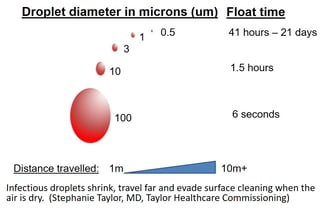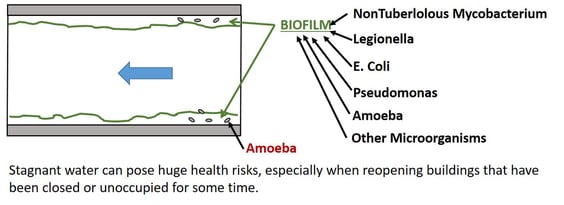With entire buildings, and even campuses, being shuttered for months on end, you can’t simply reopen a closed building and assume it will be business as usual. In reopening closed buildings during – or after – the pandemic, how building owners and maintenance staff manage the essential building functions of indoor air quality and potable water can have an enormous impact on the health and safety of tenants and visitors.
- Indoor Air, specifically the type of HVAC system and its proper operation and maintenance
- Water, specifically potable water pathways and systems, which are often overlooked
CDC air quality recommendations for reopening buildings may not be enough.

Recent CDC recommendations for HVAC align with what we at Newman Consulting Group and our colleagues in ASHRAE and other professional industry groups have been saying since last summer. Building owners and operators can maintain good air quality – keeping the coronavirus as well as other germs and viruses at bay – when taking proper precautions. For the most part, the suggested precautions follow standard operating guidelines, only intensified in scope and/or frequency.
- Increase the amount of outside air used: Although many published guidelines recommend 100% outside air, that may not be necessary, or practical, all day, all year. Know what’s best for your building and local climate. (see 100% Outside Air - Is it Really One of the Best Solutions for Flushing Buildings?)
- Maintain proper filtration: Use higher MERV (Minimum Efficiency Reporting Value) -rated filters, but be careful that the filters you choose do not reduce your air flow too much. Why? Because the higher MERV-rated filters may restrict the air flow potentially reducing the amount of air circulated into the space.
For best results and improved safety, we strongly encourage these additional measures:
- Change air filters frequently, and properly clean coils. (See Slime and Dirty Socks – How Do They Help You Save Energy and Improve IAQ?)
- Add or update air cleaning technology to match current best practice for these concerns. Consider newer technologies like ionization.
- Utilize one of the financing vehicles designed to support capital investment, like the CARES Act, or energy efficiency upgrades, like PACE or MichiganSaves.
You must have a water safety plan for your building.
Most jurisdictions don’t have guidelines for potable water use in buildings, especially after having been closed for any length of time.
Water that has been sitting in large (or small) water mains for months will have developed biofilm that can contain various bacteria and other organisms such as legionella, E.coli, etc. Long-term stagnant water presents a risk that many people will get sick when they return to work or eat in restaurants where the water systems have not been properly cleaned and disinfected.

Water lines must be properly tested, flushed and tested again. Flushing after a long period of time means more than just turning the water on and off for a couple of minutes. Depending on how far the building is from incoming lines, how large the lines are, and how long the building has been closed, flushing should be done for considerably longer periods of time, from several hours (at least) to several days (better).
If there are maintenance personnel still in the building even when everyone else is gone, flushing all the hot- and cold-water lines twice a week for 10-15 minutes at a time can mitigate issues as well as the expense of the long-term flushing and disinfection. Additionally, If the building is in an area where most of the other buildings in that area have been closed, it would be a good idea to have the fire department flush the lines to the hydrants so the biologicals that have built up in the large pipes will be flushed out.
You absolutely must have the lines tested by a competent professional. This can also help relative to potential litigation. Once completed, prominently display signs on entrance doors and throughout the building stating that it has been done. This will help people feel more comfortable – and perhaps less likely to litigate if there is an issue.
Even if a commercial building has not been completely shut down, e.g., a few people have been using the building over this time, water lines throughout must be sufficiently flushed and properly disinfected. Especially now, every building needs a Water Safety Plan or at least a water management plan that includes flushing and disinfection procedures.
Be sure to review guidelines specific to your building or community standards, including ANSI/ASHRAE Standard 188-2018 Legionellosis: Risk Management for Building Water Systems and EPA Standard GL12 Drinking Water Standard.
Any business involved in food preparation or food service, like restaurants and cafeterias, must be extra vigilant.
- Flush and disinfect any refrigerator with a water dispenser or ice maker.
- Refer to manufacturers’ directions if using a stand-alone water cooler.
- In restaurants, cafeterias, etc., flush and disinfect ice makers, draft beer or soda lines, etc.
Flushing and inspections are not for amateurs! Notice how many times we have mentioned the word “properly” in this blog. Be sure to engage competent professionals, be they consultants or trusted service contractors.
Read: Three steps to take now to improve Indoor Air Quality in the Age of Coronavirus
Watch: PACE for HVAC to Minimize Infectious Disease - Webinar



